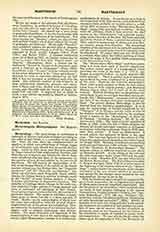

Martin of Troppau, chronicler, date of birth unknown; d. 1278. His family name was Strebski, and, being by birth a native of Troppau (Oppavia), he is also known as Martinus Oppaviensis. In his youth he entered the Dominican Order at Prague, and, as the Bohemian monasteries of the Dominicans belonged to the Polish province of the order, he was usually known as Martinus Polonus. After the middle of the thirteenth century he went to Rome, was appointed papal; chaplain and penitentiary by Clement IV (1265-8), and retained this position under the succeeding popes. On June 22, 1278, Nicholas III appointed him Archbishop of Gnesen, and performed in person the episcopal consecration. Shortly afterwards Martin set out on his journey to Poland, but fell so seriously ill on the way that he was compelled to stop at Bologna. He died at this city in the same year, and found interment there. Martin is remembered chiefly for his epitome of the history of the world (Chronica Pontificum et Imperatorum), which was the favorite handbook of the later Middle Ages. The first edition appeared during the pontificate of Clement IV (1265-8); a second recension extends to the death of this pontiff, and a third to 1277. The “Chronicle” was arranged in such a manner that the popes were treated on one side of the codex, and the emperors on the opposite page. As each page contains fifty lines, and each line the historical matter of one year, each page covers a period of fifty years. Alike in matter and in arrangement he followed the old models. The work is entirely uncritical; his sources were to a great extent legendary, and this material is again employed by him in uncritical fashion. The “Chronicle” thus contains little true history, but chiefly a mass of fables and popular legends. He admits, for example, into his third edition the fable of Popess Joan (q.v.), which indeed owes to him its wide dissemination (Chronicle ed. in Mon. Germ., Script., XXII, 397-475). The “Chronicle” was continued by many imitators of Martin. The work printed at Turin in 1477 under the title “Martini Poloni Chroneon summorum Pontificum et Imperatorum” is, however, by a later author, and has no connection with Martin of Troppau. Besides the “Chronicle”, Martin is said to have also written sermons (Sermones de tempore et de Sanctis, Argentorati, 1484), a lexicon of canon law, and a work on the Greek Schism.
J.P. KIRSCH

